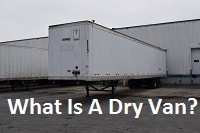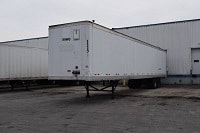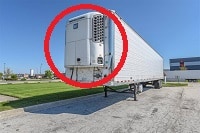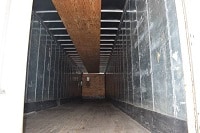 One of the most popular and most common trailers for freight is a dry van trailer. Dry van trailers are also known as box trailers. A dry van trailer is fully enclosed and they are used for freight that are nonperishable cargo, because they don’t have a way to control the trailer temperature.
One of the most popular and most common trailers for freight is a dry van trailer. Dry van trailers are also known as box trailers. A dry van trailer is fully enclosed and they are used for freight that are nonperishable cargo, because they don’t have a way to control the trailer temperature.
Usually, the dry van trailers have rear doors where the freight is loaded and unloaded.
The easiest way to tell if it is a dry van or a refrigerated trailer (these are temperature controlled) is to look for the temperature control unit, if the trailer does not have the temperature control unit on it then it is a dry van.
Here is a picture of the standard 53 ft. trailer dry van.


What Does Dry Van Mean?
A dry van means the trailer doesn’t have any way to control the temperature in the trailer.
A dry trailer is a fully closed trailer that can be sealed.
A dry van trailer is the most used trailer in the trucking industry due to its ability to move numerous products, which include plastic products, clothing, foods and beverages that are non-perishable, textile, and many other products.
The freight that is in a dry van trailer is protected from any bad weather and theft, which is another reason why the dry van trailers are the most popular trailers in the industry.
This is a picture of what the typical dry van looks like on the inside:

Dry Van Freight: What Can They Transport?
Since dry vans are the most commonly used trailers, you can look around your office or home and approximately 95% of the items were probably hauled in a dry van trailer.
Some of the items that are usually hauled in a dry van include:
• Electronics
• Furniture
• Clothing
• Flooring
• Building Materials
• Nonperishable Foods
• Nonperishable Drinks
• Laundry Soap
• Cleaning Products
• Pet Foods
• Canned Goods
• Beer
• And Any Products That Doesn’t Need Any Refrigeration
What is the Difference Between a Dry Van and Reefer Trailer?
There are several differences between a dry van and a reefer trailer, which include:
Dry Van Trailer:
• A dry van trailer is an empty box trailer that has doors in the back of the trailer where freight is loaded and unloaded.
• Any nonperishable foods can be hauled in a dry van trailer.
• Building materials, electronics, furniture, clothing, and beer are more items that is hauled in a dry van trailer.
• A dry van trailer doesn’t have any refrigeration or temperature control.
• Dry van trailers are the most used trailers.
• Freight that is being hauled in a dry van trailer is protected from theft and the elements of the weather.
• The most affordable way to transport freight is with a dry van trailer.
Reefer Trailers:
• A reefer trailer is essentially a dry van trailer, but with added insulation and a refrigeration unit.
• A reefer trailer has been specially designed to transport freight that is perishable, which include fruits, vegetables, frozen products, chemicals, and medications.
• A reefer trailer is actually preset and pre-cooled before the freight is placed into the trailer, so the freight will be delivered in perfect condition.
• The healing and cooling unit on a reefer trailer is on the front of the trailer.
• The temperature with a reefer trailer can be set from below zero to one hundred degrees, depending upon the freight that is being hauled in the reefer trailer.
In the United States, there are approximately 1.5 million dry van trailers, and nearly 400,000 reefer trailers.
Dry Van Dimensions
Dry van dimensions vary, a small straight/box truck has dimensions different than the standard 53 ft. trailer. Keep in mind though, they are both considered dry van trailer regardless of their dimensions.
The 53 ft. dry van trailer is fifty-three feet long and 102 inches wide and 9 ft. in height.
A dry van trailer can haul 45,000 pounds of freight.
A dry van trailer has doors at the rear of the trailer, and a dry van trailer can hold twenty-six pallets that are single stacked, and fifty-two pallets that are double stacked.
What Is a Dry Van Driver?
A dry van driver is a truck driver that has a Class A or B CDL.
If you need an easy to understand explanation of the differences between a Class A and Class B CDL then take a look at this article I wrote.
A CDL Class A truck driver can drive an 18-wheeler or semi attached to a dry van trailer. A CDL Class B truck driver can drive straight trucks, and box trucks.
Dry Van Trailer Facts
• The most common trailer in the United States is the dry van trailers.
• Freight is protected from theft in a dry van trailer.
• A 53 ft. dry van trailer can haul freight up to 45,000 pounds.
• Nearly 45% of fatal crashes involve a dry van trailer.
• Hardwood floors are the most common wood used in a dry van trailer.
• Dry van trailers are also known as box trailers.
• Some dry van trailers have roll up doors and swing doors.
• Dry van trailer shipping is the most affordable way to haul and ship freight.
What Type of Truck/Tractor is Needed to Haul a Dry Van Trailer?
There are several truck options that can haul a dry van trailer, which include a day cab, semi-truck, and a straight truck.
A day cab is a semi-truck without a sleeper birth and is usually used for local driving.
A semi-truck has a sleeper birth, and a straight truck has a single frame where all of the axles are attached.
To transport fright the trailer will need to be selected depending on the type of freight you need hauled.
The most popular trailer is the dry van trailers.
They are designed to haul and protect freight.
Approximately 95% of items in your home has been hauled in a dry van trailer.